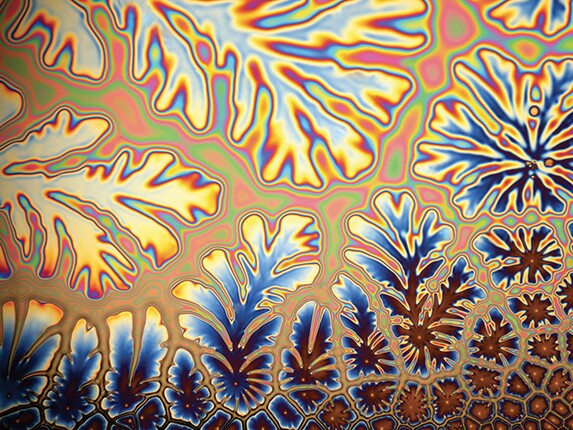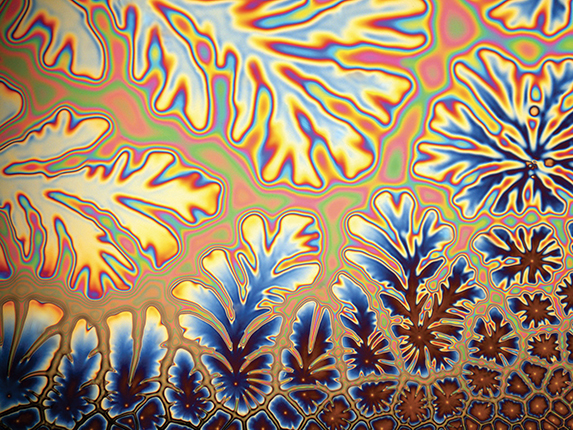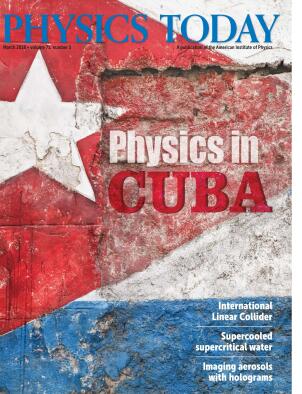Mathematics of pattern growth in condensed matter
DOI: 10.1063/PT.3.3873
Jian-Jun Xu’s book Interfacial Wave Theory of Pattern Formation in Solidification: Dendrites, Fingers, Cells and Free Boundaries covers a large and well-chosen collection of fundamental results in the field of interfacial stability and pattern formation. The author is an accomplished theoretical materials scientist who has made valuable contributions to the fields of asymptotic analysis and nonlinear partial differential equations, which are relevant in materials science, solidification physics, fluid dynamics, interfacial wave theory, pattern formation, and crystal growth.

Throughout the book, Xu starts from real-world problems and details analytical methods to describe pattern formation. Because he avoids numerical methods, his book will be a useful reference for those who are teaching courses focused on mathematical modeling or applied mathematics. The author does not hide his preference for asymptotic methods, even though they are often limited in their applications. Xu’s approach contrasts with that of other textbooks, such as Pattern Formation and Dynamics in Nonequilibrium Systems (2009) by Michael Cross and Henry Greenside, which place more emphasis on the physics of fractals and the nature of the periodicity in fractal patterns.
Xu is able to draw analogies between phenomena appearing in completely different contexts—for example, solidification of pure melts, hydrodynamic instabilities in porous media, and the eutectic growth of mixtures. However, Interfacial Wave Theory of Pattern Formation in Solidification may not stand alone as a graduate textbook, since it focuses on a wide range of mathematical methods that are sometimes quite sophisticated and omits much of the basic introductory material that one would hope for. By textbook standards, the book also lacks high-quality diagrams, photographs, and sketches. All of that should be taken into account by professors considering this book for courses.

Viscous fingers forming between the plates of a Hele-Shaw cell.
CLAIRE TREASE, KINGSTON UNIVERSITY (WIKIMEDIA COMMONS)

As a physicist working on interfacial phenomena and pattern formation in liquids, I spend much of my time trying to identify experimentally the key features of both spontaneous and artificial pattern growth and to link them to the thermodynamics of interfaces. For that reason I was particularly pleased with Xu’s coverage of material that is often missing from conventional texts on pattern growth and nonequilibrium phenomena in condensed matter. For example, Xu discusses the unidirectional solidification and spatially periodic cellular growth in the thin region between the bounding plates of a Hele-Shaw cell.
Xu begins with a short introduction on the theory of free dendridic growth and macroscopic continuum models, in which he surveys the classical hypotheses and equations governing Hele-Shaw flows and crystal growth. He then details the mathematical theory behind the Mullins–Sekerka instability that drives directional solidification. Those topics are quite rare for a textbook and extremely valuable. I much appreciated the clear distinction between cases of pattern growth in the absence of surface tension and those in the presence of interfacial stresses, which is particularly useful when Xu addresses dendridic growth and Chuoke-Saffman-Taylor instability. The text concludes with an in-depth discussion of cellular and eutectic growth.
Many cross-references throughout the book connect material in different chapters. The author also provides extensive and moderately up-to-date references to the literature, in which the reader may find more general overviews of specific topics.
The danger with a book of this size and ambition is that the central principles of pattern formation can get lost in the quantity of material presented. In a work that discusses so many topics, it is impossible to analyze and present everything in detail without losing some clarity. In many cases the author assumes that the reader has an advanced background in solidification processes. Consequently, many problems, equations, and other information may be hard for nonspecialists to understand.
For all those reasons, I cannot unreservedly recommend Interfacial Wave Theory of Pattern Formation in Solidification as a stand-alone course textbook, but I do think it would be a good guide to the literature and a possibly inspiring source for lectures focusing on the mathematical aspects of pattern formation. Moreover, such an ambitious, advanced text will surely be of great interest to mathematical physicists and researchers in chemical physics, engineering, and materials science.
More about the Authors
Domenico Truzzolillo obtained his PhD in physics at Sapienza University of Rome and continued on to positions at the Foundation for Research and Technology–Hellas in Greece and the University of Montpellier in France. He is currently a CNRS researcher at Montpellier’s Charles Coulomb Laboratory, where he is conducting research on nonequilibrium liquid interfaces and hydrodynamic instabilities.
Domenico Truzzolillo. CNRS–University of Montpellier, Montpellier, France.
